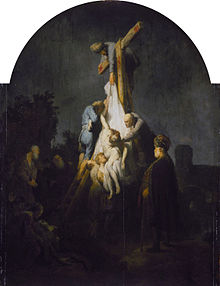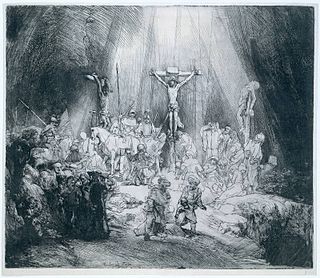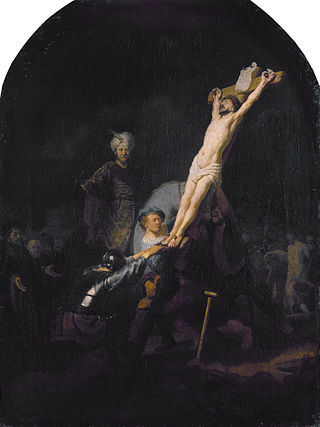
The Descent from the Cross is a 1633 painting of the Descent from the Cross by Rembrandt. It is now in the Alte Pinakothek in Munich. It is a companion piece to Rembrandt's later The Raising of the Cross . [1]

The Descent from the Cross is a 1633 painting of the Descent from the Cross by Rembrandt. It is now in the Alte Pinakothek in Munich. It is a companion piece to Rembrandt's later The Raising of the Cross . [1]
Deposition may refer to:

The Alte Pinakothek is an art museum located in the Kunstareal area in Munich, Germany. It is one of the oldest galleries in the world and houses a significant collection of Old Master paintings. The name Alte (Old) Pinakothek refers to the time period covered by the collection—from the fourteenth to the eighteenth century. The Neue Pinakothek, re-built in 1981, covers nineteenth-century art, and Pinakothek der Moderne, opened in 2002, exhibits modern art. All three galleries are part of the Bavarian State Painting Collections, an organization of the Free state of Bavaria.

Ferdinand Bol was a Dutch painter, etcher and draftsman. Although his surviving work is rare, it displays Rembrandt's influence; like his master, Bol favored historical subjects, portraits, numerous self-portraits, and single figures in exotic finery.

The Descent from the Cross, or Deposition of Christ, is the scene, as depicted in art, from the Gospels' accounts of Joseph of Arimathea and Nicodemus taking Christ down from the cross after his crucifixion. In Byzantine art the topic became popular in the 9th century, and in the West from the 10th century. The Descent from the Cross is the 13th Station of the Cross, and is also the sixth of the Seven Sorrows of the Blessed Virgin Mary.
The Kunstareal is a museum quarter in the city centre of Munich, Germany.

Lists of painters cover painters and are organized by name, nationality, gender, location, school and collection.

Rembrandt Harmenszoon van Rijn, usually simply known as Rembrandt, was a Dutch Golden Age painter, printmaker, and draughtsman. An innovative and prolific master in three media, he is generally considered one of the greatest visual artists in the history of art. It is estimated Rembrandt produced a total of about three hundred paintings, three hundred etchings, and two thousand drawings.

Aert de Gelder was a Dutch painter. He was the only Dutch artist to paint in the tradition of Rembrandt's late style into the 18th century.

The Last Supper (1630–1631) is an oil painting by Peter Paul Rubens. It was commissioned by Catherine Lescuyer as a commemorative piece for her father. Rubens created it as part of an altarpiece in the Church of St. Rombout (Rumbold) in Mechelen. The painting depicts Jesus and the Apostles during the Last Supper, with Judas dressed in blue turning back towards the viewer and away from the table. Other than Jesus, the most prominent figure is Judas. Judas holds his right hand to his mouth with his eyes avoiding direct contact with the other figures in the painting creating a nervous expression. Jesus is dressed in red and has a yellow halo surrounding his head with his face tilted upwards. Jesus is located centrally in the painting surrounded by his disciples with six on each side, and he holds a loaf of bread with a cup of wine in front of him. Out of all of the figures, he is the most in the light with the figures to the farthest left being the most in shadow. “The scene thus represents a perfect conflation of the theological significance of the Last Supper” meaning the conflation between the blessing of the bread and the wine while still being pivotal in the sense of revealing the betrayal.

The Three Crosses is a 1653 print in etching and drypoint by the Dutch artist Rembrandt van Rijn, which depicts the crucifixion of Jesus Christ. Most of his prints are mainly in etching and this one is a drypoint with burin adjustments from the third state onwards. It is considered "one of the most dynamic prints ever made".

Descent from the Cross (1634), by Rembrandt Harmenszoon van Rijn, is one of his many religious scenes. The piece is oil on canvas and now located in the Hermitage Museum in St. Petersburg. The piece is intriguing stylistically in its unique figural composition and variety of lighting effects. Aside from composition, the painting is notable in terms of its historical context, from the connection between its subject matter and Rembrandt's family situation to its endangered location during World War II.

The Descent from the Cross is a 1650–1652 painting of the Descent from the Cross by an unknown painter in the workshop of Rembrandt. It is an oil painting on canvas and is now in the National Gallery of Art in Washington.

The Portrait of Dirck van Os is a later painting by Rembrandt (1606-1669), created circa 1658. It is currently in the permanent collection of the Joslyn Art Museum in Omaha, Nebraska.

Christ and the Penitent Sinners or Christ with the four great penitents is an oil on canvas painting by Peter Paul Rubens, executed in 1617. It is now in the Alte Pinakothek in Munich.

Helena Fourment with her son Frans is a c.1635 painting by Peter Paul Rubens, showing his second wife Helena Fourment holding their second son Frans. As of 2014, it is in the Alte Pinakothek in Munich.

The Defeat of Sennacherib is an oil-on-panel painting by Peter Paul Rubens, now in the Alte Pinakothek in Munich, produced ca.1612–1614. It shows the defeat of the army of Sennacherib by an angel, as described in 2 Kings:19. It is a pendant to The Conversion of Saint Paul, now in the Courtauld Gallery in London.

The Crowning with Thorns or Christ Crowned with Thorns is an oil on canvas painting by Titian, executed in 1576, now in the Alte Pinakothek in Munich. It is a typical composition from his final period. and can be compared with an earlier 1542 work of his on the same subject.

The Entombment of Christ is an oil-on-oak panel painting by Rembrandt believed to be dated around c. 1624. It measures 32.2 x 40.5 cm. The composition is a variant of a painting of the same subject now in the Alte Pinakothek, in Munich.

David and Jonathan is a painting by the Dutch painter Rembrandt, made in 1642, now in the collection of the Hermitage Museum in Saint Petersburg, Russia. Painted on oak, it is one of the works, together with the Hellenistic sculpture acquired in 1850, The Venus de Taurida, with which the Hermitage began their collection in 1882.

Raising of the Cross is a 1633 painting by the Dutch Golden Age painter Rembrandt in the collection of the Alte Pinakothek. It was painted as part of a "passion" series commissioned in 1633 by Frederick Henry, Prince of Orange. Together with its pendant, The Descent from the Cross, it is one of the rare paintings by Rembrandt with a continuous provenance from the date of completion to today.